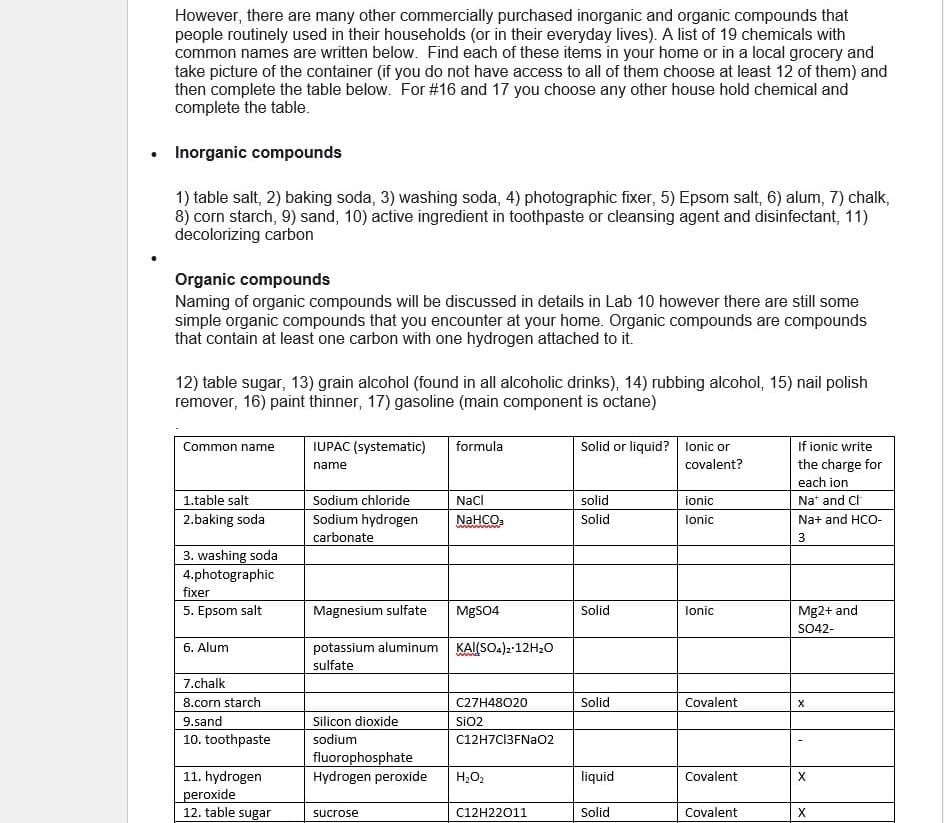12. table sugar 13. grain alcohol 14.rubbing alcohol Isopropyl alcohol 15.nail polish C12H22011 Solid Covalent sucrose Liquid liquid C3H8O covalent Propan-2-one remover 16.paint thinner
12. table sugar 13. grain alcohol 14.rubbing alcohol Isopropyl alcohol 15.nail polish C12H22011 Solid Covalent sucrose Liquid liquid C3H8O covalent Propan-2-one remover 16.paint thinner
Chapter11: Organic Compounds: Alkanes
Section: Chapter Questions
Problem 11.9E
Related questions
Question

Transcribed Image Text:However, there are many other commercially purchased inorganic and organic compounds that
people routinely used in their households (or in their everyday lives). A list of 19 chemicals with
common names are written below. Find each of these items in your home or in a local grocery and
take picture of the container (if you do not have access to all of them choose at least 12 of them) and
then complete the table below. For #16 and 17 you choose any other house hold chemical and
complete the table.
• Inorganic compounds
1) table salt, 2) baking soda, 3) washing soda, 4) photographic fixer, 5) Epsom salt, 6) alum, 7) chalk,
8) corn starch, 9) sand, 10) active ingredient in toothpaste or cleansing agent and disinfectant, 11)
decolorizing carbon
Organic compounds
Naming of organic compounds will be discussed in details in Lab 10 however there are still some
simple organic compounds that you encounter at your home. Organic compounds are compounds
that contain at least one carbon with one hydrogen attached to it.
12) table sugar, 13) grain alcohol (found in all alcoholic drinks), 14) rubbing alcohol, 15) nail polish
remover, 16) paint thinner, 17) gasoline (main component is octane)
IUPAC (systematic)
Solid or liquid? lonic or
If ionic write
the charge for
each ion
Common name
formula
name
covalent?
1.table salt
Sodium chloride
Nacl
solid
Nat and CI
ionic
Sodium hydrogen
carbonate
2.baking soda
NAHCO:
Solid
lonic
Na+ and HCO-
3
3. washing soda
4.photographic
fixer
5. Epsom salt
Magnesium sulfate
MgS04
Solid
lonic
Mg2+ and
S042-
6. Alum
potassium aluminum KAI(SO.)2-12H20
sulfate
7.chalk
8.corn starch
C27H48020
Solid
Covalent
9.sand
Silicon dioxide
SIO2
10. toothpaste
sodium
C12H7CI3FNa02
fluorophosphate
Hydrogen peroxide
11. hydrogen
peroxide
12. table sugar
H2O2
liquid
Covalent
X
sucrose
C12H22011
Solid
Covalent

Transcribed Image Text:12. table sugar
13. grain alcohol
14.rubbing alcohol Isopropyl alcohol
15.nail polish
sucrose
C12H22011
Solid
Covalent
X
Liquid
liquid
C3H8O
covalent
X
Propan-2-one
remover
16.paint thinner
Expert Solution
This question has been solved!
Explore an expertly crafted, step-by-step solution for a thorough understanding of key concepts.
This is a popular solution!
Trending now
This is a popular solution!
Step by step
Solved in 2 steps

Knowledge Booster
Learn more about
Need a deep-dive on the concept behind this application? Look no further. Learn more about this topic, chemistry and related others by exploring similar questions and additional content below.Recommended textbooks for you


Introduction to General, Organic and Biochemistry
Chemistry
ISBN:
9781285869759
Author:
Frederick A. Bettelheim, William H. Brown, Mary K. Campbell, Shawn O. Farrell, Omar Torres
Publisher:
Cengage Learning

Introductory Chemistry: An Active Learning Approa…
Chemistry
ISBN:
9781305079250
Author:
Mark S. Cracolice, Ed Peters
Publisher:
Cengage Learning


Introduction to General, Organic and Biochemistry
Chemistry
ISBN:
9781285869759
Author:
Frederick A. Bettelheim, William H. Brown, Mary K. Campbell, Shawn O. Farrell, Omar Torres
Publisher:
Cengage Learning

Introductory Chemistry: An Active Learning Approa…
Chemistry
ISBN:
9781305079250
Author:
Mark S. Cracolice, Ed Peters
Publisher:
Cengage Learning


Introductory Chemistry: A Foundation
Chemistry
ISBN:
9781337399425
Author:
Steven S. Zumdahl, Donald J. DeCoste
Publisher:
Cengage Learning

Chemistry: Matter and Change
Chemistry
ISBN:
9780078746376
Author:
Dinah Zike, Laurel Dingrando, Nicholas Hainen, Cheryl Wistrom
Publisher:
Glencoe/McGraw-Hill School Pub Co